So that you don’t feel upset to tears when you look at the spoiled fur of your favorite fur coat, so that you don’t scold yourself for bald spots on the pile and flesh - how to protect fur products, what to do for proper storage. What to do, how to protect your wardrobe from moths that eat fur coats - recommendations and advice, questions and answers. And - the opinion of experts, experience and tricks: about storing fur products, about protection, and - about the insidious moth that encroaches on our furs.
Body moth: signs and differences
Clothes, house or furniture moths are a domestic pest from the order Lepidoptera. It is also called clothing, fur coat, carpet. Insects belong to a large family of true moths , differing in size, distribution area and feeding habits.
The area of interest of the clothes moth is clear from the name. Insects actively destroy home textiles : clothing, furniture upholstery, curtains, carpets, as well as products made from natural fur. The main damage is caused by caterpillars; flying individuals are not dangerous .
At home, there are different types of moths: clothes moths, fur moths, food moths and others (read more about the fight against food pests). Butterflies differ slightly in color and size, caterpillars are practically indistinguishable from each other. Adult clothes moths have a rather inexpressive appearance.
What does a moth look like that eats a fur coat? The small insect is colored beige-silver , its narrow wings are abundantly covered with fringe, and whitish fibers are visible on the head.
The moth practically does not fly around the room; it can be detected by accidentally disturbing it in its habitat.
Adult females prefer to hide in folds of fabric and piles of things in preparation for breeding. In secluded corners, moths lay eggs, from which caterpillars hatch, causing major damage to textiles. Fast-growing caterpillars have a developed gnawing mouthpart, which allows them to quickly wear away textile fibers.
Under natural conditions, this type of moth feeds on animal hair, plant fibers, and bird feathers. In apartments, the diet of caterpillars is much richer. Their prey is any textiles, fur products, various fabric pads in furniture, and animal bristles .
Moths feed not only on natural but also synthetic products. Often it damages only the inner layer of tissue, leaving the outer layer intact. Defects can only be detected during wear; in damaged areas, the fabric quickly spreads, forming holes.
You can see what a clothes moth looks like in the photo below:
How to protect clothes: preventive measures
Moths are attracted to worn clothes with traces of sweat and sebaceous secretions . This is why holes and abrasions often appear on cuffs, collars and other places in close contact with the skin.
Clothes moths are especially partial to natural wool: cloth, drape, woolen knitwear. It also affects fur: fur coats, hats, collars and other products.
The main preventive measure is frequent washing and cleaning of clothes . Dirty clothes should not be stored in the wardrobe. Attracted by the smell of greasy secretions, moths will ruin not only them, but also clean clothes hanging nearby. Items should be washed frequently or taken to dry cleaning periodically.
Thorough cleaning is also necessary for seasonal clothing and accessories sent for long-term storage: fur coats, jackets, hats, felt boots.
Fur mittens, shoe trim, and bags made of fabric or fur need to be cleaned periodically.
Some dry cleaners offer an additional service: a non-toxic anti-mole treatment that lasts for several months.
Frequent cleaning of the inside of your closet will also help protect your clothes . You need to go through your wardrobe at least once a season. Moths love secluded corners where fresh air and sunlight do not reach.
It is important to frequently rearrange clothes folded in piles: sweaters, cardigans, scarves, warm tights. Clothes on hangers should not hang too tightly ; gaps should be left between items for ventilation. When going through your wardrobe, it is recommended to shake things; it is better to do this outdoors.
It is useful to hang woolen items in the hot summer sun . Bright rays negatively affect moth eggs and kill already hatched caterpillars. Frost has a similar effect. Hanging fur coats, coats and suits on the balcony in sub-zero temperatures helps prevent the appearance of clothes moths.
ADVICE! At the end of the winter season, it is better for owners of expensive fur coats, fur coats and stoles to store their products in special refrigerators . This service is offered by large fur salons or dry cleaners.
Consistently low temperatures kill moth larvae, the fur retains its attractive appearance longer, does not fade or become covered with dust.
How to store to preserve: fur character and requirements
And it is important to protect against moths skillfully and correctly, and to store them too.
- Mink and any fur coat requires vertical storage away from other things: the pile should not wrinkle when it comes into contact with other clothing.
- As an option, a spacious cover for outerwear protects from mechanical damage, humidity, dampness, a little heat – and from hungry “butterflies”.
- An ideal option is a refrigerator: the optimal temperature is about +5 C, humidity up to 50% - this is the comfort of the product, the absence of pests.
- Despite advice, home remedies, anti-moth tablets, it is better not to put them in your pockets, but to put them on the bottom or shelves of the closet. And if you lay it out, then only wrapped in fabric, in the form of a sachet: the clothes should not be saturated with the smell. And close proximity will not discourage the desire to bite on the fur: hungry moths and mothballs are not a hindrance.
- It is important to ventilate outer clothing, take it out into the air, into the sun. But the fur is delicate, and you shouldn’t expose it to the sun’s rays for a long time without special need: dark hair will fade, while light hair, especially the Arctic fox, will become yellow.
Bad advice: products that are not used
You can often hear truly barbaric advice that will not help, but will do harm. Do not use these products - you can get rid of the fur coat.
- You should not put your fur coat in the freezer: adult midges are not afraid of low temperatures, and only the larvae will leave the fur. But crumpling a fur coat, sending it to a cold chamber where it becomes damp, means damaging the pile and the interior.
- It cannot be ironed. Even through fabric or gauze, this is a strange idea: the high temperature will destroy the fur, and the fur coat itself will “rumble.”
- Lubrication with oil or alcohol. Two contradictory tips will not help get rid of it, but they can damage the pile, dry it out, and make it greasy. After such protection, the fur coat will need emergency rescue.
- You should not spray with homemade homemade products based on kerosene, carbolic acid and other substances that are incompatible with the beauty of fur and its long life: liquids can be oily, leave stains and even burns on the pile, leading to its loss and bald spots.
These are the ways and methods of protecting fur coats from moths in the summer, which can save the product from the insidious and voracious butterfly. Let them not come in handy!
Covers for fur coats against moths: an effective measure of protection
Covers will help protect clothes - an excellent anti-moth remedy for fur coats. They are needed for seasonal clothing made of drape, mixed fabrics and fur , which moths especially love.
Coats, fur coats, jackets, suits and dresses are stored in covers; they are suitable for transportation and protect clothes from dust.
Products can be purchased at hardware stores (for example, the Raptor brand); the best options for storing valuable mink and sable coats are offered in specialized fur salons.
The best covers are made from modern synthetic materials that do not interfere with normal air exchange. They are hermetically fastened with a zipper or Velcro tape.
Products may be impregnated with repellent drugs. Such covers are very effective , but anti-moth impregnations are toxic and not suitable for allergy sufferers .
Soaked products should be protected from children and pets; clothes packed for storage should be placed in the closet so that they do not touch other things. It is advisable to allocate a separate section for it. Impregnated anti-moth covers remain effective for up to 12 months .
An alternative could be a product made from thick cotton or thin plastic. You can make a convenient case yourself.
The style is simple : a rectangle with a sewn bottom and a zipper along the entire length. The size depends on the length of the product; the coat or fur coat should fit into the case freely, without tucking.
Hand-sewn covers must be washed every year after the end of the storage season. They can be treated from the inside with aerosol preparations that repel moths. At home, it is better to use odorless preparations. They irrigate not only the covers, but also the walls of the wardrobe.
Watch a video on how to properly prepare a fur coat for storage:
LiveInternetLiveInternet
—Categories
- “Tyap-lyapki” (pictures-postcards) from Irina (12)
- AVATARS (5)
- Bard's song (2)
- Video mini (5)
- VIRTUAL CHAPEL (1)
- All about Li.ru (65)
- HOW TO SAVE YOUR DIARY TO YOUR COMPUTER (4)
- How to use special codes (BB codes)? (7)
- HOW TO REMOVE RADIO FROM LIRU and ALL UNUSUAL (3)
- Calendars with clocks and greetings (18)
- Font color (4)
- fonts (1)
- All about Li.ru No. 1 (21)
- FLU, what to do (2)
- Sad things about our life (49)
- Dacha (19)
- For computer (58)
- about antiviruses (12)
- For computer No. 1 (41)
- life stories (159)
- stories from KSYU8 (5)
- stories from Slava SE (2)
- Life stories №1 (33)
- substitutes for expensive drugs (2)
- Hooked, to the soul (43)
- Celebrities (25)
- GAMES (5)
- IDEAS, TIPS (2)
- interesting (152)
- Interesting to see! (47)
- interesting#1 (26)
- Interesting diaries of my friends (10)
- Internet, LiRU (506)
- simple frames No. 1 (10)
- ARGUMENTS (19)
- pictures (51)
- pictures"thank you,comments" (27)
- very simple (50)
- simple frames (154)
- frames (14)
- “girls” frames (78)
- animal frames (7)
- frames "men" (2)
- “he and she” frames (29)
- nature frames (13)
- frames "Flowers" (3)
- culinary frames (3)
- holiday frames (New Year's, etc.) (2)
- frames with formulas (2)
- there are a lot of different frames (40)
- LiRu's LESSONS (2)
- Letter color in frame (2)
- fonts (1)
- Interior (52)
- Kitchens (23)
- Interior 1 (16)
- cinema (171)
- cinema 2022 (2)
- movie posts 2016 (50)
- movie posts 2022 (21)
- movie posts 2022 (5)
- BOOKS (19)
- transition buttons (2)
- BEAUTY, DIETS, EXERCISES (50)
- Beauty, diet, exercise 1 (4)
- Beauty, Health (tips) (275)
- Bodyflex (5)
- Health (56)
- Health No. 2 (52)
- health#1 (50)
- Health#3 (39)
- Beauty (35)
- Beauty#1 (28)
- HONEST TALK WITH YOUR DOCTOR ABOUT DRUGS AND MEDICINE. (7)
- BEAUTY OF NATURE (2)
- Lana Famicheva /Poetry and prose/ (5)
- FASHION,STYLE (33)
- For women with curves (13)
- MOE (10)
- Prayers, faith No. 1 (37)
- Prayers, faith (56)
- Motivators (4)
- Music (16)
- thoughts, quotes (158)
- thoughts from. (45)
- Thoughts, quotes#1 (26)
- MOOD of the day (7)
- Natalia Volnistaya.Stories (5)
- Our children (29)
- New Year's and Christmas (52)
- Required sites (72)
- Websites with animated images and more (4)
- Required sites1 (9)
- relationships (44)
- Cleansing a house or a person (including with a candle) (8)
- Congratulations (35)
- POSITIVE (99)
- Positive dog-cat, all-animal (31)
- Positive #1 (29)
- useful tips (271)
- for home (44)
- for house No. 1 (43)
- Life tricks (31)
- About flowers (41)
- photo tips (19)
- Useful tips from tet369 (7)
- politics (10)
- For back pain (11)
- Proverbs No. 2 (36)
- Proverbs#1 (62)
- About animals (50)
- About animals#1 (23)
- About fulfillment of desires (37)
- Simply beautiful (127)
- Painting (46)
- Simply beautiful #1 (5)
- psychology (537)
- from psychologist Lilia Grad (28)
- psychology of life№1 (34)
- psychology life (187)
- psychology he and she (104)
- psychology he and she No. 1 (50)
- psychology he and she No. 2 (7)
- psychology work (6)
- purely feminine (54)
- Purely feminine 1 (18)
- Psychology. Anna Kiryanova (4)
- PSYCHOSOMATICS (16)
- travel (56)
- beauty of my homeland (10)
- Our beautiful planet (40)
- Travel #1 (15)
- miscellaneous (2)
- Stories. Nadezhda Kutueva (3)
- Repair (1)
- Recipes (504)
- baked goods (50)
- baked goods 1 (70)
- baking 2 (26)
- Blanks (36)
- casseroles (50)
- casseroles1 (11)
- cooking tips (21)
- multicooker,microwave (17)
- meat, chicken (50)
- Meat, chicken 1 (42)
- vegetables (49)
- Vegetables1 (7)
- various recipes, cooking tips (47)
- fish (20)
- salads (50)
- Salads1 (12)
- No-bake cakes (1)
- DRAWING (7)
- handicrafts (402)
- Felting (1)
- pattern-base and other patterns (50)
- patterns1 (19)
- Knitting (9)
- Clothes decor (41)
- Knitted toys (8)
- home decor ideas (38)
- TILDA dolls (2)
- Master classes and decor ideas (17)
- scarves, stoles (6)
- sewing curtains (3)
- Handicraft sites (15)
- From the site “Second Street” secondstreet.ru (8)
- We sew BAGS (23)
- sewing technique (43)
- photos of clothes, interior, etc. (44)
- COLORS, combination (9)
- Sewing (87)
- sewing video (36)
- Blessed memory (2)
- Cimaron (54)
- Cimaron1 (24)
- TALES for adults (9)
- Elf fairy tales and other psychological fairy tales (48)
- Emoticons + code (2)
- Poems (967)
- poems by Irina Samarina -Labyrinth2 (40)
- Poems are positive! (53)
- Poems - positive No. 1 (49)
- Poems - positive No. 2 (13)
- Sad poems No. 1 (102)
- Sad poems No. 2 (46)
- poems by Irina Samarina -Labyrinth1 (51)
- Poems about life (476)
- poems he and she, love (23)
- Poems he and she are sad No. 1 (51)
- Poems he and she are sad No. 2 (18)
- poems by Svetlana Chekolaeva (1)
- Poetry . Marina Troyanskaya (6)
- poems by Alesya Sineglazaya (4)
- Poems Vikhareva Julia (6)
- Poems by Ksenia Gazieva (5)
- Poems by Lal Tarapakin (3)
- POEMS Malvina Matrasova (18)
- Poems about a woman (13)
- Poems about animals (52)
- poems about animals№1 (38)
- Poems about life No. 1 (50)
- Poems about life No. 2 (50)
- Poems about life No. 3 (50)
- Poems about life No. 4 (39)
- Poems he and she.№2 (41)
- Poems he and she are sad No. 2 (17)
- Poems he and she are sad No. 1 (6)
- Poems he and she. (394)
- Poems he and she.№3 (31)
- Simple poems (89)
- simple poems 1 (8)
- POEMS BY JULIA OLIFER (12)
- Poems, Katya Volkova (4)
- Poetry. Irina Matsigura (4)
- Poems.Marta Yakovleva (2)
- Schemes for Liru (49)
- Schemes for Liru1 (50)
- Schemes for Liru2 (8)
- tests, fortune telling (67)
- Painting and drawing lessons (1)
- WE LOSE WEIGHT. (4)
- handmade, how to make money (8)
- Quote of the day (41)
- Esoterics (307)
- Affirmations (6)
- horoscope (43)
- Conspiracies (4)
- Healing pictures and fulfilling wishes! (7)
- Meditations, videos, moods (35)
- numerology (27)
- miscellaneous (56)
- miscellaneous1 (24)
- Runes, amulets (8)
- Palmistry (5)
- Digital mantras (2)
- Esoterics and health (11)
- Energy (3)
- Esoterics №1 (32)
- Elchin Safarli (2)
- THIS IS YOU NEED TO KNOW (23)
- humor (128)
- humor #1 (28)
Fighting methods: modern and folk
How to get rid of moths in a clothes closet? Moth larvae and adult butterflies about to lay eggs do not like the strong aromas of citrus and lavender .
You should place fresh orange or tangerine peels in the cupboard, which will have to be changed frequently.
An alternative would be essential oil of orange, tangerine, lemon or grapefruit . Strips of fabric soaked in oil are placed in cases with clothes and on wardrobe shelves.
It is important to ensure that the oil does not get on your clothes and leave permanent stains on them.
It is useful to place a sachet of dried lavender in your closet . Dried inflorescences retain a recognizable pungent aroma for a long time. To activate volatile substances, the sachet needs to be crushed in your hands from time to time.
If you don’t have natural fragrances on hand, scented soap will help . The pieces, with or without cardboard packaging, are laid out in different places in the wardrobe, periodically replaced with fresh ones. The only disadvantage of this method is the noticeable aroma with which things are saturated.
Strong-smelling products effectively repel adult moths, but they are unable to influence the behavior of already hatched larvae. You should use fragrances and sachets only after thoroughly disinfecting your wardrobe .
A more modern option is fumigators . The plates will be inserted into the device connected to the outlet. When heated, they activate volatile substances that are safe for humans and pets, but kill larvae and adult moths.
Symptoms of infection
Moth larvae on clothes.
Unfortunately, the first symptoms of moths appearing in a closet are quite difficult to detect, because they initially lay eggs, which are almost transparent.
Therefore, if one or two caterpillars accidentally hit, it is very difficult to see them right away. But you should be careful, because these voracious caterpillars very quickly turn into butterflies, one of which can lay up to 200 eggs at a time.
Symptoms of infection appear as follows:
- The fur product looks as if it is in pellets.
- Folds or clipped paths appear on a mink coat or any other fur.
- If some of the villi begin to fall out in thick fur, then it is necessary to carefully inspect the fur coat, because the hairs interfere with the free movement of the caterpillars.
- When bald patches appear on the surface of clothing, this is the first sign of moths eating your fur coat.
- The main sign, which is already obvious with a strong scale of infection, is the appearance of winged individuals.
If one or more of these symptoms are already confirmed and observed, it is necessary to immediately proceed to comprehensive protection.
How to protect a fur coat from moths?
Fur products are threatened by leather beetles and fur moths. But even ordinary clothes are partial to fur coats, hats and collars .
REFERENCE! The larvae gnaw the pile, leaving noticeable bald spots on fur coats. Most often, the sleeves, front and back, as well as the area at the collar are affected.
Insects are especially partial to short-haired fur: astrakhan fur, astrakhan fur, and mink. Moths can also damage the lining, leaving holes in it . Having noticed the slightest signs of pests, you need to urgently take measures to save your favorite fur coat.
A moth has eaten my fur coat, what should I do? The product is removed from the wardrobe and placed on wide hangers. It is best to hang the fur coat in a cool room : on a glassed-in loggia or veranda. First, the fur is cleaned with a brush from the outside and inside . Then the fur coat must be thoroughly shaken , removing moth larvae and eggs.
The fur coat is generously sprayed with repellent designed to destroy moth larvae.
For home use, products that are unscented or have a neutral lavender scent are suitable. Choose drugs with minimal toxicity.
It is better to carry out work with gloves, protecting the respiratory tract with a gauze bandage. Not only the top of the fur coat is processed, but also the lining and the inside of the sleeves . Carefully spray the area under the collar or hood, cuffs, decorative elements, and folds.
ADVICE! It is convenient to process a very wide fur coat in a horizontal position, laid out on a table or ironing board.
Do not use repellents that have expired; they are practically useless. You cannot use several products from different manufacturers at the same time ; many drugs do not combine with each other, forming harmful fumes.
After treatment, the fur coat is left for half an hour and then placed in a sealed case with anti-mole impregnation . It is better to leave the product outdoors for 1-2 days, and then put it in a separate section of the closet. Before placing the fur coat in the wardrobe, you need to treat the walls and shelves with repellents and ventilate thoroughly.
You should not place wool products stored without covers next to your fur coat. It is better to remove felt boots, yarn supplies and other items that attract moths from the section where fur is stored.
It is very difficult to completely eradicate clothes moths. However, timely preventive measures, hygiene and attention to your own wardrobe will help keep your clothes intact. It’s important to remember that preventing pests is easier than making them leave your home forever.
NOTE! There is a wax moth that lives in beehives. A tincture based on its larvae has many medicinal properties.
Why does it appear
Traces of wear of a fur coat by moths.
Moths appear in houses primarily because it is much more comfortable to live here than in nature. There are all amenities for life, suitable temperature, dryness and darkness.
The main thing is that there is enough tasty food here, thanks to which the caterpillar can recover enough to make a cocoon for itself, turn into a butterfly and lay eggs.
Fur moths appear on fur products due to improper care . Due to prolonged wear, microparticles of dirt and sweat remain on clothes - which is an excellent energy reserve for the larvae.
It is the contaminated villi of any fur that are the most pleasant food for the pest.
Also, in parallel, the caterpillars remove tracks of hairs that interfere with their movement, thus building certain passages for themselves. Therefore, you can often notice narrow paths on fur coats, as if cut to zero.











